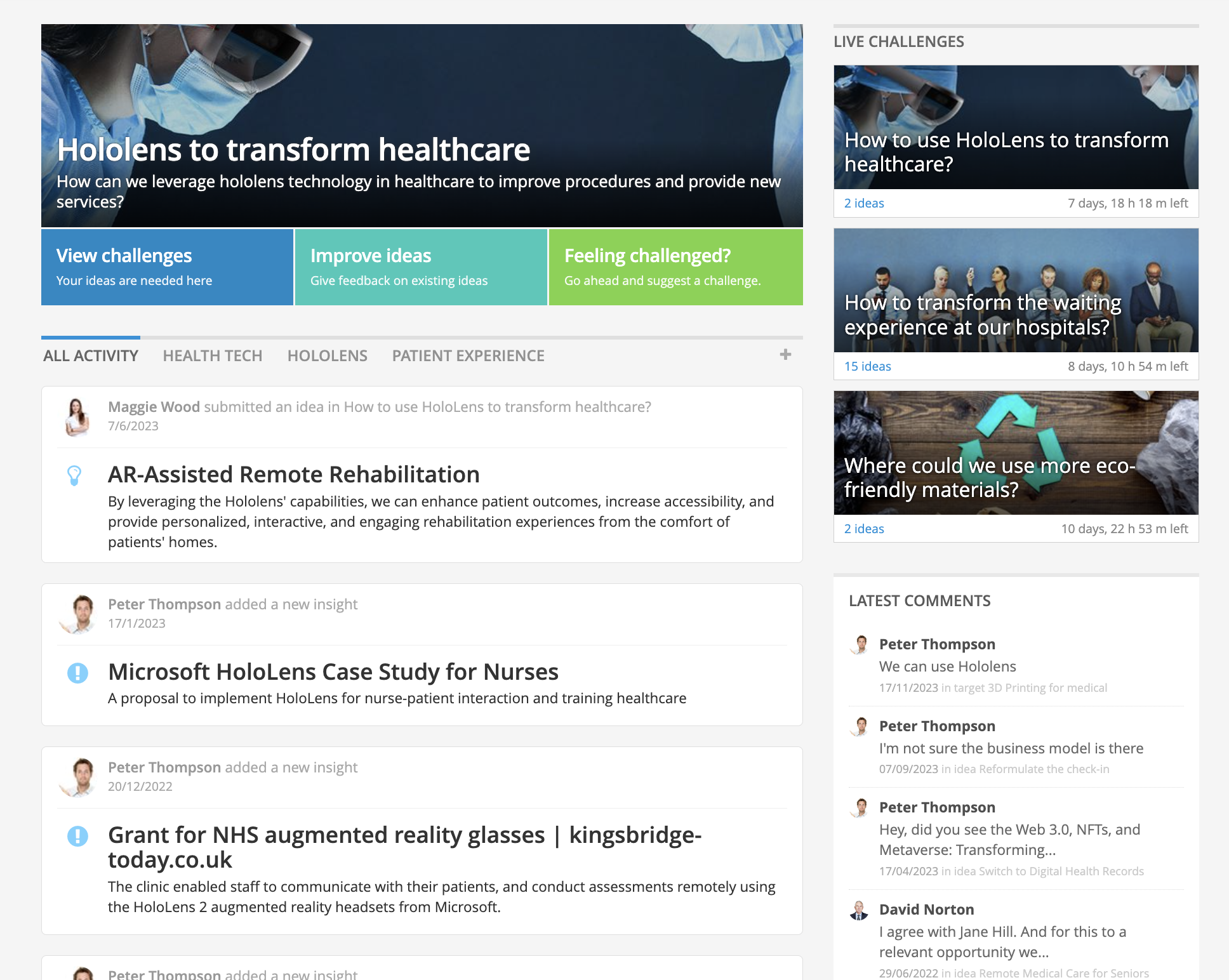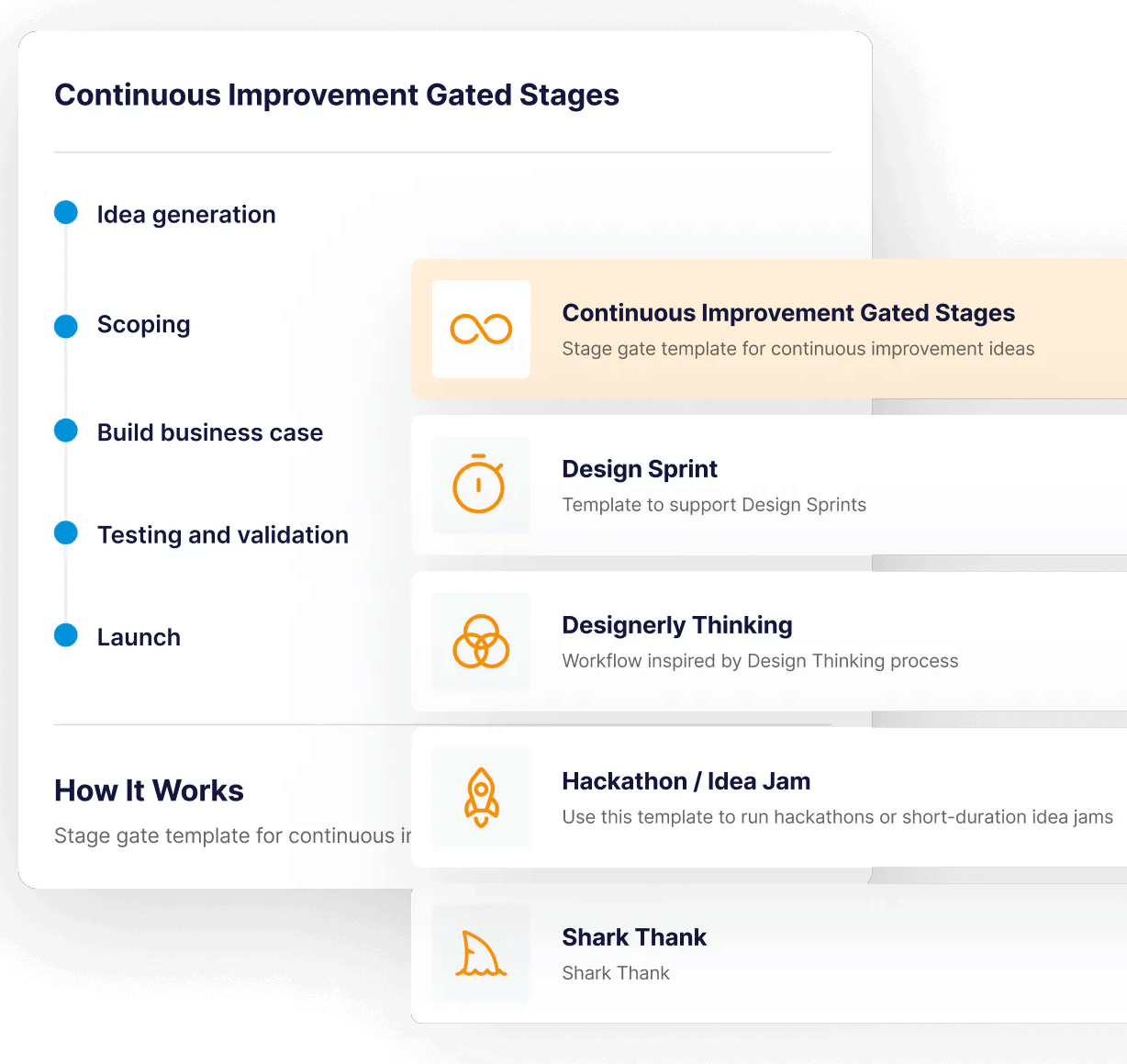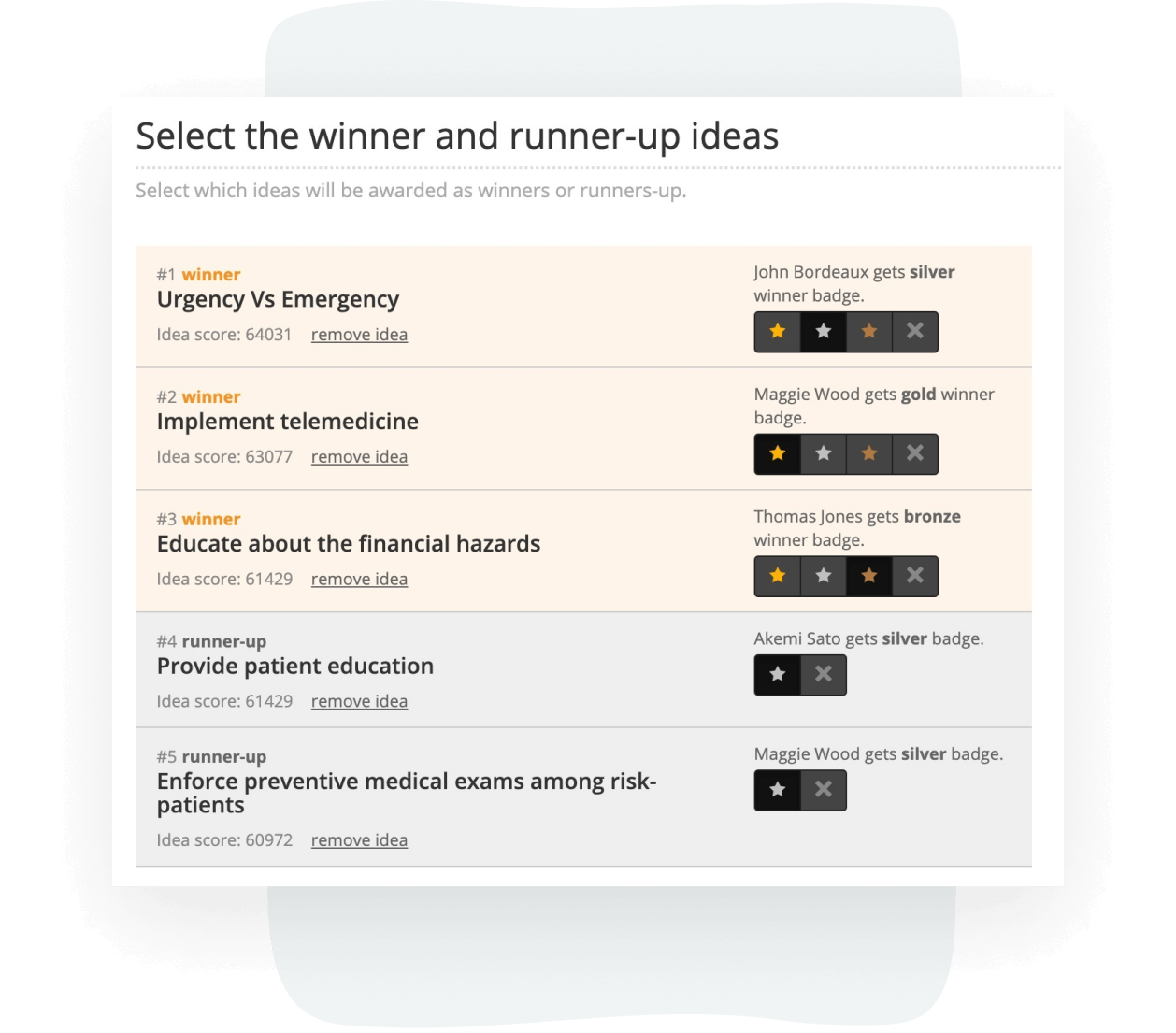Taking innovations from idea to implementation usually involves six steps:
Idea Generation — Department managers collect ideas aligned with current priorities.
Idea Improvement — Authors refine their ideas based on feedback from colleagues and experts.
Idea Evaluation — Managers and experts assess ideas for further development.
Idea Prioritization — Managers and stakeholders decide which ideas to implement first.
Idea Testing and Validation — Teams conduct experiments to confirm ideas and deliver value.
Idea Implementation — Organizations plan and assign tasks for implementation.
We’ll explore each step in detail, highlight common mistakes, and share best practices.
We’ll cover the importance of continually analyzing and optimizing the implementation process, where innovation managers review past projects to identify inefficiencies and improve current innovation processes.
Additionally, we’ll examine the tools needed to effectively manage innovations, explaining why innovation management software is preferred over project management tools and spreadsheets.
To learn more about establishing an effective innovation process, schedule a free consultation with the InnovationCast team.
Step 1: Idea Generation
Innovation managers organize idea collection in order to get as many high-quality ideas related to their priorities as possible. They typically do this by having employees submit ideas via a web page or company email address.
However, we often see that innovation managers fail to keep employees informed about the types of ideas to submit. They may create a “digital collection box” for ideas, asking employees to submit anything they believe is relevant. But these ideas often pertain to only employees’ specific roles or departments and may align with broader organizational goals. As a result, many ideas are discarded.
To address this, we recommend posting Innovation Challenges to inform employees about the organization’s priorities and encourage submissions that align with key objectives.
Inform Employees About the Organization’s Priorities Using Innovation Challenges
Innovation Challenges are time-bound requests for employees and potentially external participants, such as partners and customers, to submit ideas on specific topics.
The primary benefit of posting these challenges is that they keep participants updated on the organization’s goals and innovation strategy and only allow them to submit relevant ideas. This approach allows challenge managers to gather ideas directly related to their areas of interest, rather than collecting any and all ideas from employees.
Challenge managers can enhance each posting by attaching additional information, such as customer interviews and market research data. This context helps employees understand the nuances of the priority and leads to higher-quality ideas.
Submission forms can also be used to improve idea quality by prompting authors with questions that help refine their ideas and justify their implementation.
For example, a product manager might launch a challenge to improve an existing product but wants to avoid ideas like "Build an AI feature" or "Use blockchain technology." By using submission forms, they can filter out those types of ideas.
Finally, due to the time-constrained nature of challenges, employees are encouraged to brainstorm and collaborate on potential solutions before the challenge ends, helping managers gather ideas that are aligned with the company’s goals within a set timeframe.
How InnovationCast Supports Strategic Idea Collection
InnovationCast offers two main ideation features:
Time-bound Innovation Challenges
“Always On” Category-based Idea Collection
Innovation managers and stakeholders can create challenges tied to current priorities. Then, they can attach resources that help users understand the priority in more detail. Finally, they can set a deadline that urges users to submit ideas before the challenge ends.

Then, when a user submits an idea, challenge managers can require them to complete a submission form explaining their idea in more detail, improving the quality of ideas.

If innovation managers and stakeholders prefer a more passive approach to idea collection, they can use our “Always On” Category-based idea collection feature, allowing users to submit ideas any time.
Most importantly, innovation managers can establish areas of interest that tell users what ideas they’re looking for and only accept ideas that fit into one of these areas.

Read more: 7 Strategies to Get Innovative Ideas from Employees
Step 2: Idea Improvement
After collecting ideas, leading innovation programs typically involve an improvement step. During this phase, employees and external subject matter experts review ideas and provide feedback to the original authors on how to improve them.
It's important to remember that most ideas aren’t perfect upon submission, so this step leverages additional brain power to refine them, leaving innovation managers with a list of more refined ideas.
A common mistake many organizations make during the idea improvement step is simply asking employees and outside users to vote on what they think of an idea. While this approach helps you uncover the most popular ideas, these ideas aren’t always the best. Additionally, this voting approach gives no opportunity for authors to discuss and improve their ideas alongside colleagues and outside experts.
Instead, we recommend encouraging employees to provide their colleagues with actionable feedback rather than just voting. This allows idea authors, colleagues, and experts to collaboratively refine ideas to get them in the best shape possible before evaluation.
With InnovationCast, managers can showcase selected ideas to stakeholders, external users, and employees.

They can prompt users to improve ideas by responding to them with thoughtful feedback and working with authors to make their ideas better.
This way, everyone from the organization can contribute insights and help original authors iterate on their ideas.
Read more: How to Create a Collaborative Innovation Process and Network
Step 3: Idea Evaluation
Organizations that implement steps one and two will have an extensive list of ideas that could help them address current priorities.
During idea evaluation, the goal is to evaluate and filter ideas and determine which ones are worth validating (more on idea validation later).
The approach many companies use during this stage is to have a handful of innovation managers evaluate all idea submissions. However, this method has three limitations:
Innovation managers don't have the time to evaluate all ideas. It's nearly impossible for a team of three to five innovation managers to evaluate a thousand ideas, for example.
Innovation managers don't have the expertise to evaluate all ideas. In a large organization, ideas related to R&D, engineering, sales, finance, and countless other fields are submitted. Even if they had the time, innovation managers don't have the expertise in each field to know which ideas to pursue.
Innovation managers can't draw insights from different perspectives. Siloing idea evaluation within the innovation team often causes managers to miss valuable opinions and feedback from other departments that might not have been considered.
To avoid this, we recommend the following best practices:
Enable Each Department to Manage Its Own Ideas
The innovation department cannot be responsible for evaluating all ideas. What we see working really well are cases in which innovation departments work alongside local departments on high-uncertainty, high-potential ideas that require more strategic planning and resource allocation.
However, for continuous improvement ideas where there’s little risk and high certainty, i.e., making incremental changes to existing products and processes, innovation teams should delegate idea management to local departments.
The innovation team can provide structure to these departments by helping them define processes, evaluation criteria, idea development activities, and impact-tracking methods.
For example, if someone in engineering has an idea for using new modeling and simulation software, the local department should evaluate the idea.
Innovation management teams are usually small and understaffed, and organizations cannot expect them to manage and evaluate all ideas. The key concept here is enabling local departments to manage innovation independently.
Use Idea Evaluation Models to Evaluate Low-Risk Ideas and the Scorecard Method for High-Risk Ideas
Local departments can organize the idea evaluation process using either idea evaluation models or the scorecard method.
For less risky ideas, such as improving the hiring process, departments can use an evaluation model. These models include high-level questions to assess an idea's feasibility and potential benefits, helping managers focus on the most promising ideas.
There are various evaluation models companies can use depending on what types of ideas they want to evaluate; however, one recommend evaluation model is RICE:
Reach: How many people can this idea impact?
Impact: What effect can this idea have on the company?
Confidence: How confident are you in your ability to execute this idea?
Effort: How much effort is required to implement this idea?
For riskier ideas, such as launching a new product or service, the scorecard method is appropriate. Scorecards contain assumptions about an idea's impact, viability, and risk.
Committees within the organization conduct experiments to prove or disprove these assumptions. This allows them to gauge an idea's potential, compare their results with other committee members, and vote on which ideas to pursue.
For further reading on evaluating innovation ideas, check out our guide: Best Practices to Evaluate Innovation Ideas
How InnovationCast Supports Idea Evaluation
To help innovation managers evaluate ideas, we added configurable idea evaluation workflows within InnovationCast. These are like roadmaps that show step-by-step what should happen to understand whether to implement an idea or table it.
Our solution comes with preset workflows for different types of ideas: product development ideas, business model ideas, operational process ideas, business ideas, continuous improvements, and more.

During each stage of these workflows, innovation managers can invite teams to complete specific tasks — the product team may develop an MVP, or the finance team may build a business case. This way, everyone understands what needs to happen and what they’re responsible for to validate a certain idea.
However, you can modify these steps (it’s as easy as dragging, dropping, and editing) and create new workflows for different types of ideas and initiatives. You can also save multiple workflows within our system to easily push ideas through their respective flows without modifying them each time.
Step 4: Idea Prioritization
It’s important to remember that an organization can’t realistically implement every single idea. Even with a list of 100 promising ideas guaranteed to create value, resources are generally insufficient to tackle them all simultaneously.
Some ideas will produce more value than others, and some will be more urgent due to current challenges. To determine which ideas to prioritize, department leaders typically consult stakeholders, employees, and outside experts to vote on which ideas to implement first and in what order.
How InnovationCast Helps Innovation Managers Prioritize Ideas for Launch
InnovationCast has features that allow department managers to invite key stakeholders to vote on which ideas to implement.

When stakeholders and other users log into their InnovationCast dashboard, they can see all selected ideas, analyze their impact on the organization, and vote on which ideas they believe are “winners” and “runners-up.”
Step 5: Idea Testing & Validation
Once department managers have evaluated ideas, they need to validate them before implementation. This allows them to thoroughly explore an idea’s potential risks, constraints, and benefits.
Most ideas organizations collect won’t go through this step; instead, they will go directly to implementation. This is because they’re small improvements to existing products, services, and processes with a lot of data backing them. If, for whatever reason, the idea isn’t successful, it won’t cost the organization much in terms of resources.
However, for riskier ideas with more resources at stake and a lot of uncertainty around whether they’ll be successful, organizations need to reduce uncertainty as much as possible and gain confidence in the idea before implementation. They do this by creating and assigning validation tasks to certain team members.
For example, if an organization wants to launch a new mobile app, these validation tasks may include building a business case, conducting market research, sketching a minimum viable product (MVP), and interviewing customers.
The key here is that the steps to validate ideas vary depending on the kind of idea. While validating a new mobile application may require product teams to sketch a prototype, give a few customers access, and get their thoughts, validating an internal process may include interviewing stakeholders, analyzing existing processes, and running simulations to assess efficiency gains.
This is why we recommend designing custom development workflows to test different ideas.
How InnovationCast Supports Testing & Validation
Innovation teams can plan validation tasks, assign them to certain teams, employees, and outside users, and track their progress inside the InnovationCast dashboard.
For example, say the innovation department is validating three ideas: a patient-carer boot camp, a mobile phone app, and a new waiting room MVP. They could create and assign validation tasks for each project (e.g., seating requirements, mobility assistance, field testing) and track their statuses.

Additionally, InnovationCast has a portfolio management feature that displays a history of all previous implementations. This way, innovation managers can reflect on past projects, learn from their mistakes, and use these lessons to improve ongoing implementations.
Step 6: Idea Implementation
Once department managers have validated an idea and decided to implement it, they usually send it to the project management office, which oversees the entire implementation process.
Generally speaking, this implementation phase often involves creating and assigning tasks to various teams, establishing timelines for when these tasks are due, allocating resources, and ensuring the innovation is launched on time.
However, for smaller ideas where there aren't a lot of implementation steps, maybe the engineering team wants to use a new simulation software because they believe it can improve their work processes; these implementation steps could be as simple as buying the licensing for the new software and training the engineering team to use it.
The important thing to note here is that while validation helps reduce risk, you can never eliminate it. So, for high-risk, high-potential ideas, where the implementation stage still has a lot of uncertainty, it's important for innovation departments to work alongside the project management office to refine the innovation according to new discoveries and insights.
Continually Track & Optimize Workflows
A key aspect of building an effective innovation program is tracking previous projects’ metrics, learning from mistakes, and using this information to improve ongoing and future implementations continuously.
However, many organizations don’t do this. They consider launching an idea a success. But many teams experience road bumps along the idea to implementation process, and some ideas just don’t pan out how teams expect.
To continually improve and drive innovation, we recommend tracking the outcomes of past projects, analyzing the project flow, and working with stakeholders and employees to uncover any inefficiencies in the implementation process. Then, you have the data and insights to optimize evaluation flows or project plans productively, and future implementations can run smoother.
To do this effectively, innovation managers require a portfolio management tool that allows them to monitor in-progress projects and keep a historical record of past implementations. Most innovation management software, like InnovationCast, includes portfolio management.
Read more: How to Measure Innovation: Essential KPIs & Best Practices
How InnovationCast Supports the Tracking of Live Innovations
Innovationcast’s portfolio management feature allows innovation managers to monitor both current and previous implementations through a comprehensive dashboard. This includes tracking key details, successes, and shortcomings of previous ideas.
Managers can easily review which ideas succeeded, which fell short of expectations, and identify any inefficiencies to refine workflows in the future.
By leveraging the successes and failures of past projects, innovation managers can launch new innovations more efficiently.
Getting Started
Innovation managers can use an array of tools to support these six key steps — survey forms, spreadsheets, project management software, etc. — but innovation management software is specifically designed to support innovation. This often includes:
Targeted idea collection features to gather ideas relevant to the innovation strategy.
Collaborative feedback tools to vote on ideas and facilitate constructive conversations.
Evaluation workflows to validate ideas before approving them for launch.
Prioritization tools to vote on and rank promising ideas.
Project and portfolio management to plan implementation tasks and track past projects.
Our team has been working with innovation departments for 10+ years to help them refine their processes, get organized, build a strong innovation program, and reach new milestones. We have experience with names big and small, including household brands like DHL and Visa.
We offer a free consultation and demo so you can meet with our team to discuss your questions and challenges. We can walk you through our software and features, tailor InnovationCast to your workflows and requirements, and assist you through onboarding to support adoption.
If you’re interested in learning more about developing an innovation process and how innovation management software can support those endeavors, schedule a free demo with our team.
Related Reads:

